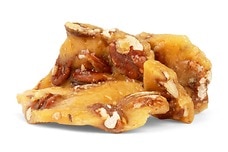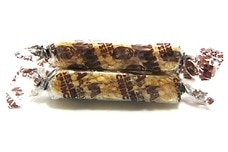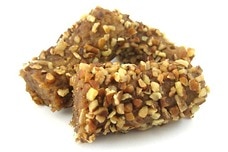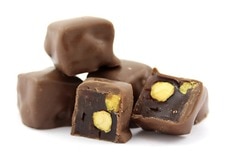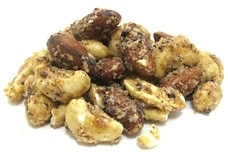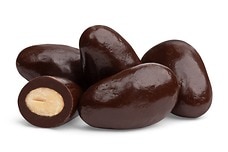Healthy Desserts
For those of us with a sweet tooth, dessert is the most exciting part of a meal. Unfortunately, it can also be the most incorrigible. Finding a way to indulge while maintaining a commitment to wellness can prove to be a particularly prodigious step towards a healthier life.
Looking Closely at Dessert Nutrition
Typical dessert recipes -- chocolate cake, brownies with ice cream, cherry pie -- are often made without nutrition in mind. After all, the logic goes, if you’re going to indulge in dessert, you might as well really indulge! But, this approach may not be entirely tenable. Learning the components that are the likeliest culprits in common desserts can help you better understand which desserts to avoid and which to select when your sweet tooth strikes.
Carbohydrates
One of the largest problem areas for typical desserts is their carbohydrate load. Now, not all carbohydrates are bad for you. There are three main types of carbohydrates in the foods we eat (American Diabetes Association, 2015). Starches are longer, more complex carbohydrate chains. These carbs are found in starchy vegetables (e.g., corn, potatoes, or peas), dried beans, barley, brown rice, and oats. Complex carbohydrates are a type of starch that includes the bran, germ, and endosperm of a grain. Getting more complex carbohydrates in your diet is associated with lower risk of cardiovascular disease (Liu et al., 2000). The second type of carbohydrate is fiber. Fiber is the indigestible part of a plant. Getting enough fiber not only improves heart health but also leaves you feeling fuller for longer.
The third and final type of carbohydrate is sugar. Sugars are a simpler type of carbohydrate on a molecular level. They are also the type of carbohydrate that is featured most prominently in desserts. Some sugars occur naturally, as in milk or fruits. However, the majority of sugars added to desserts are refined sugars. These might include white sugar, powdered sugar, high-fructose corn syrup, or brown sugar (American Diabetes Association, 2015).
Fats
TThe other major culprit in desserts is fat. Again, not all fats are bad. There are three major types of fats: trans, saturated, and unsaturated. Trans fats are found naturally in some animal products and are found in some processed foods. In fact, processed sweets such as cakes, muffins, and cookies are one of the largest sources of trans fats in the American diet (American Heart Association, 2016). Trans fats are associated with a significantly higher risk of cardiovascular disease, making it important to steer clear of these unhealthy fats.
Saturated fats are also an unhealthy component of many desserts. Saturated fats can be found in butter, full-fat dairy products, lard, cream cheese, and coconut oil. Consuming too much saturated fat leads to an increase in the levels of “bad” LDL cholesterol in your bloodstream, which can contributes to several issues related to heart health.
The final type of fat is unsaturated fats. These fats are actually associated with higher levels of “good” HDL cholesterol and lower levels of LDL cholesterol. Unfortunately, desserts do not traditionally contain unsaturated fats, which are found in almonds, walnuts, avocados, peanut butter, and vegetable oils.
Ingredient Substitutions for Healthy Desserts
Making simple ingredient substitutions can lighten desserts without compromising their flavor. Consider the following substitutions for healthy desserts that have lower levels of saturated fat (Mayo Clinic, 2014):
- Replace half of the called-for butter with applesauce or prune puree to decrease saturated fat consumption.
- Swap heavy cream for nonfat milk or fat-free evaporated milk.
- Choose Neufchatel cheese or fat-free cream cheese over the full-fat variety.
- Replace full-fat sour cream with nonfat versions.
- Replace an egg with one banana or ¼ cup of applesauce in baked goods.
Reducing the sugar or limiting content of desserts is another healthy move. For most baked goods, you may simply cut the amount of sugar by half without sacrificing flavor or texture. Adding vanilla, nutmeg, cinnamon, or other warm spices is a good way to intensify flavors. Alternatively, swapping sugar for agave nectar or honey can boost sweetness and result in a sweet taste while using less total sugar..
Healthy Dessert Recipes
These recipes were selected for their conservative use of ingredients that increase saturated fat intake and their inclusion of healthy alternatives to refined sugars and other typical dessert ingredients..
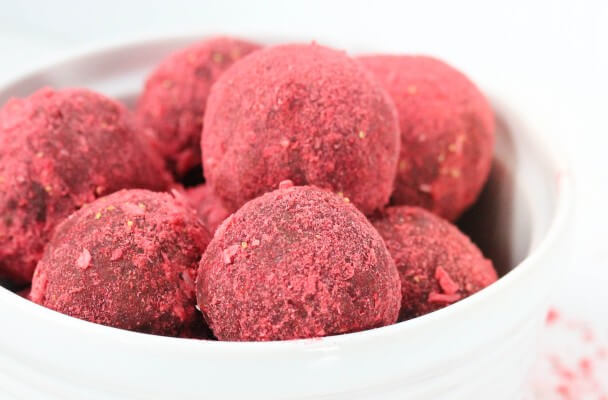
Almond Truffles Recipe {gluten-free, vegan}
Love the soft savor of a rich truffle? These lightweight almond truffles offer the same angelic sensation with a much healthier composition and a delightful hint of almond flavor to complement the tart taste of raspberry.
Ingredients: Pitted dates, almond flour, almond butter, water, flaxseed meal, freeze-dried raspberries, unsweetened shredded coconut.
Total Time: 15 minutes
| Yield: 14 - 16 truffles

Healthy Vegan Chocolate Truffle Recipe
Another truffle recipe for those that prefer the traditional taste of chocolate, these truffles are low in calories and contain very little fat to offer an incredible confection to tickle your sweet tooth. And did we mention it’s vegan?
Ingredients: Jumbo Mejdool dates, almond flour, chia seeds, flaxseed meal, cacao powder, agave or maple syrup, almond milk, unsweetened shredded coconut.
Total Time: 15 minutes
| Yield: 24 truffles
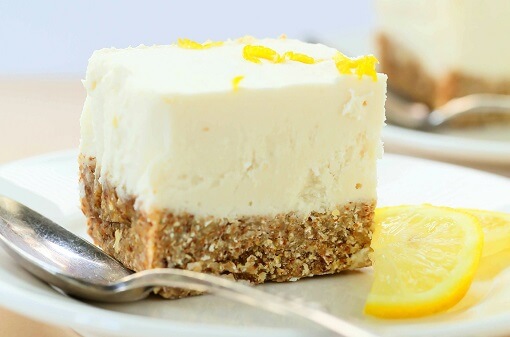
No-Bake Lemon Cheesecake Bites Recipe {luten-free, vegan}
This lemon cheesecake is easy to make and offers a source of both protein and fiber in each delicious bite. These components help keep you fill to limit your intake of this terrifically tart dessert.
Ingredients: Raw almonds, unsweetened shredded coconut, gluten-free rolled oats, flaxseed meal, maple syrup, lemons, coconut cream, macadamia nuts, slivered almonds.
Total Time: 20 minutes
| Yield: 15 servings
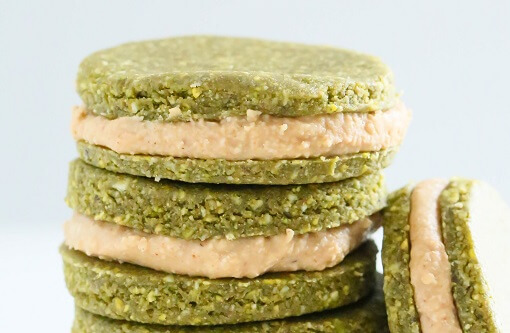
No-Bake Pistachio Cookies Recipe {gluten-free, vegan}
Another recipe that doesn’t require the use of an oven, these delectable sandwich cookies complement the full flavors of pistachio with the natural saccharinity of coconut. The resulting ambrosia also offers both protein and fiber to help you feel full.
Ingredients: Pistachios, unsweetened shredded coconut, gluten-free rolled oats, maple syrup, moringa powder, water, vanilla extract, cashews, almond butter, vanilla, coconut oil.
Total Time: 20 minutes
| Yield: 16 cookies

Blueberry Chia Jam Bars Recipe {gluten-free, vegan}
These crumbly bars combine the superfood chia seed another antioxidant powerhouse: blueberries. Gluten-free rolled oats offer a heart-healthy base for a treat that is sweet without overdoing the sugar.
Ingredients: Raw almonds, gluten-free rolled oats, chia seeds, maple syrup, water, vanilla or almond extract, blueberries, cacao powder, coconut oil.
Total Time: 30 minutes
| Yield: 16 mini bars
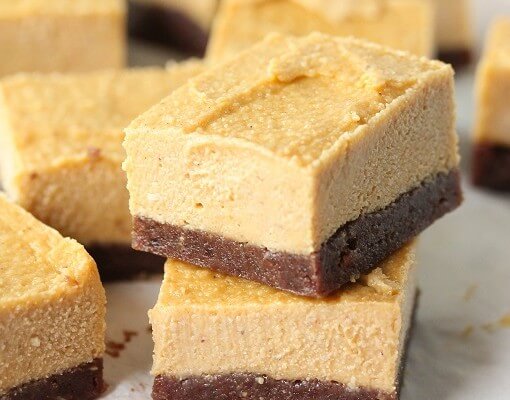
No-Bake Cheesecake Bites Recipe {gluten-free}
Another soft sweet with a delightfully seasonal palate, these pumpkin bites offer the perfect treat for fall or those that miss it. A base of dates, cacao powder and almond-based ingredients offer a complimentary sensation that is simply superb!
Ingredients: Pitted dates, almond flour, cacao powder, vanilla extract, almond milk, raw cashews, maple syrup, canned pumpkin, pumpkin spice.
Total Time: 20 minutes
| Yield: 16 - 20 squares
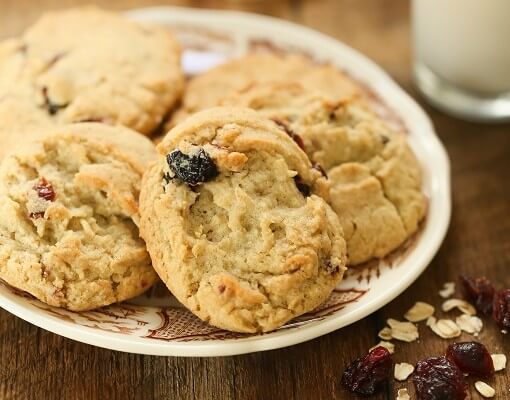
Cranberry Almond Flour Cookies Recipe {gluten-free}
Searching for something more traditional? These almond flour cookies utilize brown rice flour and almond flour to create a confection that tastes as delectable as classic cookies without any gluten!
Ingredients: Brown rice flour, almond flour, rolled-oats, dried cranberries, egg, coconut oil, sugar, vanilla extract, baking soda.
Total Time: 25 minutes
| Yield: 20-22 cookies
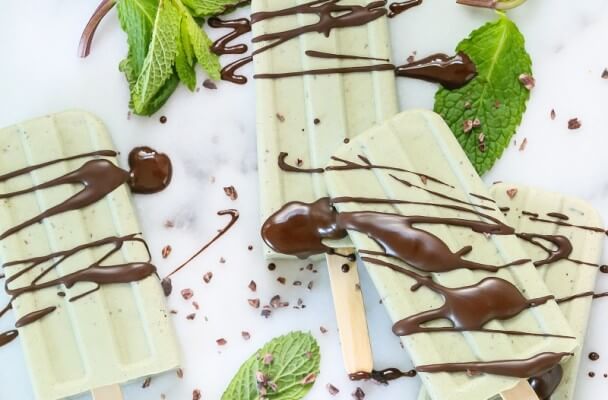
Mint Chocolate Popsicle Recipe {vegan}
Enjoy the classic combination of mint and chocolate in this fabulous frozen treat. This recipe makes use of brilliant substitutes to offer a full flavor without the added fats and calories.
Ingredients: Coconut cream, cacao powder, cacao nibs, maple syrup, spirulina, mint extract, coconut oil, dark chocolate chips (vegan)
Total Time: 30 minutes
| Yield: 7 popsicles
Healthy Dessert Options
For those that prefer a ready made sweet treat or a decadent dessert without all the fuss, check out the suggestions below for a healthier, equally opulent option.
Healthy Eating
- Healthy Snacks
- Healthy Highlights
- 5 Uses for Cacao Powder
- 5 Ways to Eat Farro
- 6 Best Gluten-Free Foods
- Alcohol and the Body
- Almond Flour Recipes
- Anti-Aging Superfoods
- Beat the Afternoon Slump
- Benefits of a Plant-Based Diet
- Benefits of Baobab
- Benefits of Cashews
- Benefits of Coconut Oil for Hair
- Benefits of Coconuts
- Benefits of Dates
- Benefits of Fenugreek
- Benefits of Garcinia Cambogia
- Benefits of Goji Berries
- Benefits of Kale Chips
- Benefits of Monk Fruit Sweetener
- Benefits of Peanuts
- Benefits of Pecans
- Benefits of Pistachios
- Benefits of Pumpkin Seeds
- Benefits of Spelt Flour
- Benefits of Steel Cut Oats
- Benefits of Sunflower Seeds
- Benefits of Tiger Nuts
- Benefits of Turmeric
- Benefits of Walnuts
- Benefits of Wheatgrass
- Best Food Fads
- Cacao vs Cocoa
- Caffeine-Free Energy Foods
- Chocolate That's Good for You
- Diet vs. Exercise
- Fat Burning Foods
- Food Myths Debunked
- Foods for Bone Density
- Foods for Colon Health
- Foods for Healthy Hair
- Foods for Healthy Skin
- Foods to Help Sleep
- Foods to Reduce Stress
- Green Tea Benefits
- Healthy Baking Flours
- Heart Healthy Habits
- High Protein Health Risks
- How to Boost Your Metabolism
- How to Lose Weight While Aging
- How to Throw a Vegan BBQ
- Kaniwa vs Quinoa
- Little Health Foods
- Low-Carb: Fad or Friend?
- Making Healthier Desserts
- Mediterranean Diet Meal Plan
- Natural Beauty Products
- Nuts for Weight Loss
- Preparing Vegan Meals
- Preventing Muscle Degeneration
- Rare Superfoods
- Reduce Sugar Intake
- Save Time By Going Vegan
- Smarter Snack Swaps
- Smoothie Ingredients
- Soy Protein vs Whey Protein
- Starting a Plant-Based Diet
- Steel Cut vs Rolled Oats
- Sugar Substitutes
- Vegan Proteins
- Vegan Substitutions for Fall Recipes
- Why Go Vegan
- Healthy Recipes
- Sports Nutrition
- Nutrition and Special Diets
- 21 Day Fix
- 5 Popular Diet Similarities
- Alkaline Diet
- Anti-Inflammatory Diet
- Calorie Counting
- Carb Cycling Diet
- Celiac Disease
- Cholesterol
- Clean Eating
- Crohn's Disease
- DASH Diet
- Detox Diet
- Diabetes
- Diabetes Diet
- Diet Pill Dangers
- Fat Burning Foods
- Gluten-free Diet
- Glycemic Index
- Heart Health
- High Blood Pressure Diet
- High Fiber Foods
- How to Eat Healthy
- How to Lower Blood Pressure
- Hypertension
- IBS Diet
- Ketogenic Diet
- Liquid Diet
- Low GI Foods
- Low-Carb Diet and Foods
- Low-Fat High-Carb Diet
- Mediterranean Diet
- Mediterranean Diet Foods
- Military Diet
- Nutrition Labels Explained
- Paleo Diet
- Raw Food Diet
- Superfoods
- Sustainable Weight Loss
- Thrive Diet
- Vegan Diet
- Vegetarian Diet
- Weight Loss Shakes
- Whole30
- Vitamins, Minerals & Nutrients

